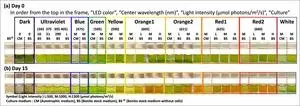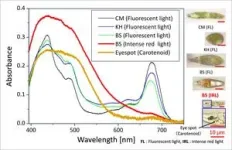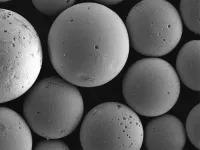(Press-News.org) BUFFALO, N.Y. — The key to growing coffee plants that can better resist climate change in the decades to come may lie in the ancient past.
Researchers co-led by the University at Buffalo have created what they say is the highest quality reference genome to date of the world’s most popular coffee species, Arabica, unearthing secrets about its lineage that span millennia and continents.
Their findings, published today in Nature Genetics, suggest that Coffea arabica developed more than 600,000 years ago in the forests of Ethiopia via natural mating between two other coffee species. Arabica’s population waxed and waned throughout Earth’s heating and cooling periods over thousands of years, the study found, before eventually being cultivated in Ethiopia and Yemen, and then spread over the globe.
“We’ve used genomic information in plants alive today to go back in time and paint the most accurate picture possible of Arabica’s long history, as well as determine how modern cultivated varieties are related to each other,” says the study’s co-corresponding author, Victor Albert, PhD, Empire Innovation Professor in the UB Department of Biological Sciences, within the College of Arts and Sciences.
Coffee giants like Starbucks and Tim Hortons exclusively use beans from Arabica plants to brew the millions of cups of coffee they serve everyday, yet, in part due to a low genetic diversity stemming from a history of inbreeding and small population size, Arabica is susceptible to many pests and diseases and can only be cultivated in a few places in the world where pathogen threats are lower and climate conditions are more favorable.
“A detailed understanding of the origins and breeding history of contemporary varieties are crucial to developing new Arabica cultivars better adapted to climate change,” Albert says.
From their new reference genome, accomplished using cutting-edge DNA sequencing technology and advanced data science, the team was able to sequence 39 Arabica varieties and even an 18th century specimen used by Swedish naturalist Carl Linnaeus to name the species.
The reference genome is now available in a publicly available digital database.
“While other public references for Arabica coffee do exist, the quality of our team’s work is extremely high,” says one of the study’s co-leaders, Patrick Descombes, senior expert in genomics at Nestlé Research. “We used state-of-the-art genomics approaches – including long- and short-read high throughput DNA sequencing – to create the most advanced, complete and continuous Arabica reference genome to date.”
Humanity’s favorite coffee evolved without people’s help
Arabica is the source of approximately 60% of the world’s total coffee products, with its seeds helping millions start their day or stay up late. However, the initial crossbreeding that created it was done without any intervention from humans.
Arabica formed as a natural hybridization between Coffea canephora and Coffea eugenioides, whereupon it received two sets of chromosomes from each parent. Scientists have had a hard time pinpointing exactly when — and where — this allopolyploidization event took place, with estimates ranging everywhere from 10,000 to 1 million years ago.
To find evidence for the original event, UB researchers and their partners ran their various Arabica genomes through a computational modeling program to look for signatures of the species’ foundation.
The models show three population bottlenecks during Arabica’s history, with the oldest happening some 29,000 generations — or 610,000 years — ago. This suggests Arabica formed sometime before that, anywhere from 610,000 to 1 million years ago, researchers say.
“In other words, the crossbreeding that created Arabica wasn't something that humans did,” Albert says. “It’s pretty clear that this polyploidy event predated modern humans and the cultivation of coffee.”
Coffee plants have long been thought to have developed in Ethiopia, but varieties that the team collected around the Great Rift Valley, which stretches from Southeast Africa to Asia, displayed a clear geographic split. The wild varieties studied all originated from the western side, while the cultivated varieties all originated from the eastern side closest to the Bab al-Mandab strait that separates Africa and Yemen.
That would align with evidence that coffee cultivation may have started principally in Yemen, around the 15th century. Indian monk Baba Budan is believed to have smuggled the fabled “seven seeds” out of Yemen around 1600, establishing Indian Arabica cultivars and setting the stage for coffee’s global reach today.
“It looks like Yemeni coffee diversity may be the founder of all of the current major varieties,” Descombes says. “Coffee is not a crop that has been heavily crossbred, such as maize or wheat, to create new varieties. People mainly chose a variety they liked and then grew it. So the varieties we have today have probably been around for a long time.”
How climate impacted Arabica’s population
East Africa’s geoclimatic history is well documented due to research on human origins, so researchers could contrast climate events with how the wild and cultivated Arabica populations fluctuated over time.
Modeling shows a long period of low population size between 20-100,000 years ago, which roughly coincides with an extended drought and cooler climate believed to have hit the region between 40-70,000 years ago. The population then increased during the African humid period, around 6-15,000 years ago, when growth conditions were likely more beneficial.
During this same time, around 30,000 years ago, the wild varieties and the varieties that would eventually become cultivated by humans split from each other.
“They still occasionally bred with each other, but likely stopped around the end of the African humid period and the widening of the strait due to rising sea levels around 8,000 to 9,000 years ago,” says Jarkko Salojärvi, assistant professor at Nanyang Technological University in Singapore and another co-corresponding author of work.
Low genetic diversity threatens Arabica
Cultivated Arabica is estimated to have an effective population size of only 10,000 to 50,000 individuals. Its low genetic diversity means it could be completely decimated, like the monoculture Cavendish banana, by pathogens, such as coffee leaf rust, which causes $1-2 billion in losses annually.
The reference genome was able to shed more light on how one line of Arabica varieties obtained strong resistance to the disease.
The Timor variety formed in Southeast Asia as a spontaneous hybrid between Arabica and one of its parents, Coffea canephora. Also known as Robusta and used primarily for instant coffee, this species is more resistant to disease than Arabica.
“Thus, when Robusta hybridized itself back into Arabica on Timor, it brought some of its pathogen defense genes along with it,” says Albert, who also co-led sequencing of the Robusta genome in 2014. Albert and collaborators’ current work also presents a highly improved version of the Robusta genome, as well as new sequence of Arabica’s other progenitor species, Coffea eugenioides.
While breeders have tried replicating this crossbreeding to boost pathogen defense, the new Arabica reference genome allowed the present researchers to pinpoint a novel region harboring members of the RPP8 resistance gene family as well as a general regulator of resistance genes, CPR1.
“These results suggest a novel target locus for potentially improving pathogen resistance in Arabica,” Salojärvi says.
The genome provided other new findings as well, like which wild varieties are closest to modern, cultivated Arabica coffee. They also found that the Typica variety, an early Dutch cultivar originating from either India or Sri Lanka, is likely the parent of the Bourbon variety, principally cultivated by the French.
“Our work has not been unlike reconstructing the family tree of a very important family,” Albert says.
Nestlé Research funded the majority of the research. The large international team was co-led by Albert, whose work was supported by the National Science Foundation, and contributions from many other organizations. Other UB contributors include Trevor Krabbenhoft, PhD, and Zhen Wang, PhD, both assistant professors of biological sciences; PhD student Steven Fleck; PhD graduate Minakshi Mukherjee; and former research scientist Tianying Lan – all from the Department of Biological Sciences.
END
Newly sequenced genome reveals coffee’s prehistoric origin story — and its future under climate change
Study charts family history of Arabica, world’s most popular coffee species, through Earth’s heating and cooling periods over last millennia
2024-04-15
ELSE PRESS RELEASES FROM THIS DATE:
Human muscle map reveals how we try to fight effects of ageing
2024-04-15
How muscle changes with ageing, and tries to fight its effects, is now better understood at the cellular and molecular level with the first comprehensive atlas of ageing muscles in humans.
Researchers from the Wellcome Sanger Institute and their collaborators at Sun Yat-sen University, China applied single-cell technologies and advanced imaging to analyse human skeletal muscle samples from 17 individuals across the adult lifespan. By comparing the results, they shed new light on the many complex processes underlying age-related muscle changes.
The atlas, published ...
Study shows key role of physical activity and body mass in lung function growth in childhood
2024-04-15
A new study led by the Barcelona Institute for Global Health (ISGlobal), a centre supported by the "la Caixa" Foundation, sheds light on the growth of lung function in children. The results show that increased levels of physical activity and a higher body mass index (BMI) play a key role in the recovery of early deficits. These findings, published in the journal Thorax, have important implications for clinical practice, research and public health policy, providing new insights into how to improve respiratory health from childhood to adulthood.
The study analysed data from the ...
Security vulnerability in browser interface allows computer access via graphics card
2024-04-15
Modern websites place ever greater demands on the computing power of computers. For this reason, web browsers have also had access to the computing capacities of the graphics card (Graphics Processing Unit or GPU) in addition to the CPU of a computer for a number of years. The scripting language JavaScript can utilise the resources of the GPU via programming interfaces such as WebGL and the new WebGPU standard. However, this harbours risks. Using a website with malicious JavaScript, researchers from the Institute of Applied Information Processing and Communications at Graz University of Technology (TU Graz) were able to spy on information about data, keystrokes and encryption ...
Physical activity reduces stress-related brain activity to lower cardiovascular disease risk
2024-04-15
Key Takeaways
Results from a new study indicate that physical activity may help protect against cardiovascular disease in part by reducing stress-related brain activity
This effect in the brain may help to explain why study participants with depression (a stress-related condition) experienced the greatest cardiovascular benefits from physical activity.
BOSTON – New research indicates that physical activity lowers cardiovascular disease risk in part by reducing stress-related signaling in the brain.
In the study, which was led by investigators at Massachusetts General Hospital (MGH), a founding member of the Mass General Brigham healthcare ...
Inaugural International COSPAR Planetary Protection Week: Set to inspire global collaboration in London
2024-04-15
With an increasing number of space missions targeting various celestial bodies, including Mars, Europa, and the Moon, the importance of maintaining the integrity of these environments while protecting our own biosphere has never been greater. The ICPPW will serve as a platform for promoting international collaboration and knowledge exchange on best practice in planetary protection.
The event will feature a range of sessions, meetings, as well as panel discussions, covering key topics such as the current and ...
A quarter of deaths among young adults in Canada were opioid related in 2021
2024-04-15
Premature deaths related to opioids doubled between 2019 and 2021 across Canada, with more than 1 in 4 deaths among young adults aged 20–39 years attributable to opioids, according to new research published in CMAJ (Canadian Medical Association Journal) https://www.cmaj.ca/lookup/doi/10.1503/cmaj.231339.
Opioid-related deaths have continued to increase over the past decade across Canada, with 6222 deaths occurring in 2021. This trend worsened during the COVID-19 pandemic, although the scale and rapidity of increases varied across provinces and territories. ...
Severe morning sickness: how to diagnose and treat
2024-04-15
Severe morning sickness in pregnancy, known medically as hyperemesis gravidarum, can negatively affect both maternal and infant health. A review published in CMAJ (Canadian Medical Association Journal) https://www.cmaj.ca/lookup/doi/10.1503/cmaj.221502 provides information to clinicians on the causes, diagnosis, and treatment of the condition.
Although nausea and vomiting are common in pregnancy, affecting as many as 70% of pregnancies, severe vomiting and nausea can prevent people from eating and drinking sufficiently, leading to weight loss and ...
Digging up new species of Australia and New Guinea’s giant fossil kangaroos
2024-04-15
Palaeontologists from Flinders University have described three unusual new species of giant fossil kangaroo from Australia and New Guinea, finding them more diverse in shape, range and hopping method than previously thought.
The three new species are of the extinct genus Protemnodon, which lived from around 5 million to 40,000 years ago – with one about double the size of the largest red kangaroo living today.
The research follows the discovery of multiple complete fossil kangaroo skeletons from Lake Callabonna in arid South Australia in 2013, 2018 and 2019. These extraordinary fossils allowed lead researcher ...
Carbon beads help restore healthy gut microbiome and reduce liver disease progression
2024-04-15
Innovative carbon beads, invented by researchers at UCL, reduce bad bacteria and inflammation in animal models, which are linked to liver cirrhosis and other serious health issues.
The study, published in Gut, found that the carbon beads, licensed to UCL-spinout Yaqrit, were effective in restoring gut health and had a positive impact on liver, kidney and brain function in rats and mice. They were also found to be safe for human use.
The next step will be to see if the same benefits can be realised in humans, which would ...
School suspensions and exclusions put vulnerable children at risk
2024-04-15
Managing problematic student behaviour is one of the most persistent, challenging, and controversial issues facing schools today. Yet despite best intentions to build a more inclusive and punitive-free education system, school suspensions and expulsions remain.
Now, new research from the University of South Australia shows that exclusionary practices not only fail to identify the deep-rooted causes of challenging student behaviours but exacerbate negative issues rather than resolve them.
Lead researcher, UniSA’s Professor Anna Sullivan, says schools face difficult decisions around ...
LAST 30 PRESS RELEASES:
The best hydrogen for heavy-duty transport is locally produced and green
Pregnancy-related high blood pressure varied among Asian, Pacific Islander subgroups
Measuring movement creates new way to map indoor air pollution
Europe’s crop droughts to get worse even as rain increases
New study identifies signature in blood to better predict type 2 diabetes risk
Research spotlight: developing “smart” nanoparticles to deliver targeted gene therapy in osteoarthritis
A CRISPR fingerprint of pathogenic C. auris fungi
Time warp: How marketers express time can affect what consumers buy
CBD treatment reverses key effects of fetal alcohol spectrum disorder in a mouse model
Blood sugar spikes linked to higher risk of Alzheimer's disease
Staying single for longer affects young people’s well-being
New method allows scientists to 3D-print structures within cells
Screening tool helps identify brain-related comorbidities in individuals with Duchenne muscular dystrophy
How do the active ingredients of monkfruit affect health?
News language and social networks: how do they affect the spread of immigration attitudes?
Researchers discover trigger of tendon disease
Your pet's flea treatment could be destroying the planet
Diabetes risk not associated with timing or type of menopause
Bulk inorganic crystals grown from water emit “handed” light
A new AI-based attack framework advances multi-agent reinforcement learning by amplifying vulnerability and bypassing defenses
While exploring the cosmos, astronauts also fuel explorations of the biology of aging and cellular resilience
Design and synthesis of Zr-IR825 nanoparticles for photothermal therapy of tumor cells
Food critics or food grabbers? When choosing food, wood mice split into careful examiners who sniff and handle, and quick nut grabbers
‘Cosmic clock’ reveals Australian landscapes’ history and potential future
Higher maternal blood pressure increases the risk of pregnancy complications, study concludes
Postoperative complications of medical tourism may cost NHS up to £20,000/patient
Phone apps nearly 3 times as good as no/basic support for quitting smoking long term
Female sex and higher education linked to escalating prevalence of obesity and overweight in Africa
THE LANCET + eCLINICALMEDICINE: Two studies on reductions in mortality from small changes lifestyle changes
AI model identifies how every country can improve its cancer outcomes
[Press-News.org] Newly sequenced genome reveals coffee’s prehistoric origin story — and its future under climate changeStudy charts family history of Arabica, world’s most popular coffee species, through Earth’s heating and cooling periods over last millennia





